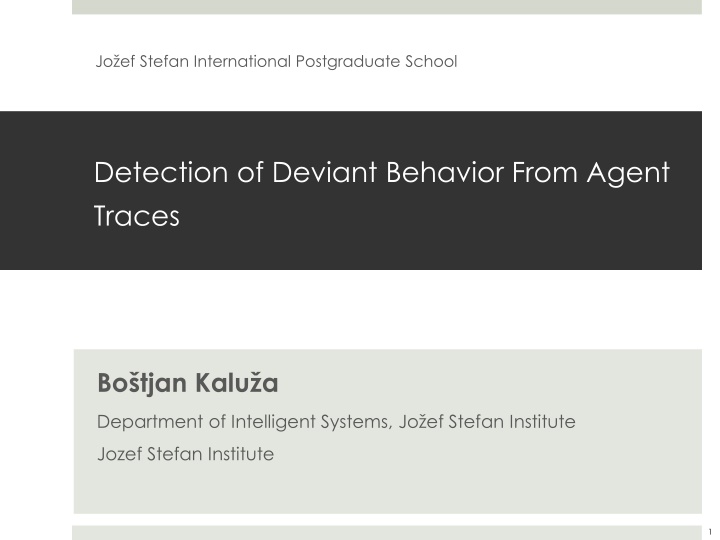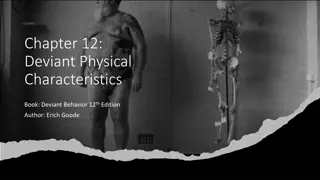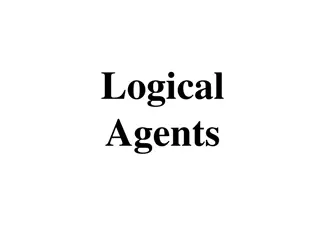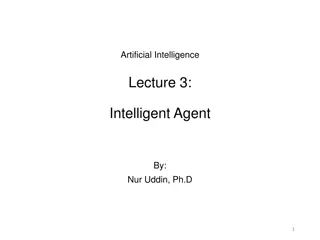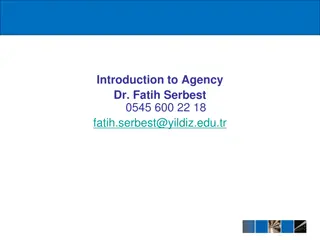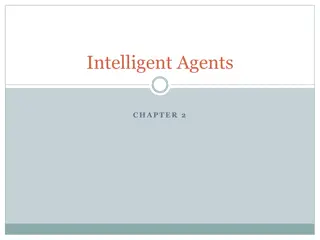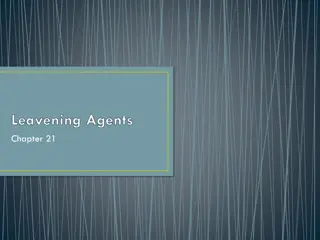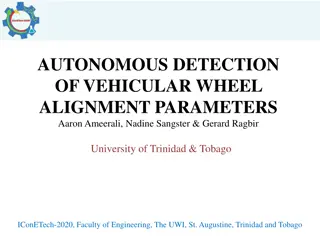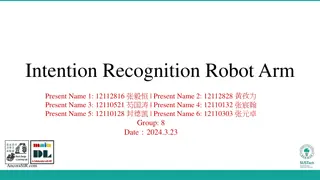Unified Detection Framework for Deviant Behavior Recognition in Autonomous Agents
This study focuses on detecting deviant behavior in autonomous agents using spatio-temporal traces and behavior patterns. It explores the challenges of recognizing activities and representing complex behaviors, emphasizing the need for multi-view detectors and accumulators for comprehensive behavior assessment.
Download Presentation

Please find below an Image/Link to download the presentation.
The content on the website is provided AS IS for your information and personal use only. It may not be sold, licensed, or shared on other websites without obtaining consent from the author.If you encounter any issues during the download, it is possible that the publisher has removed the file from their server.
You are allowed to download the files provided on this website for personal or commercial use, subject to the condition that they are used lawfully. All files are the property of their respective owners.
The content on the website is provided AS IS for your information and personal use only. It may not be sold, licensed, or shared on other websites without obtaining consent from the author.
E N D
Presentation Transcript
Joef Stefan International Postgraduate School Detection of Deviant Behavior From Agent Traces Bo tjan Kalu a Department of Intelligent Systems, Jo ef Stefan Institute Jozef Stefan Institute 1
Introduction: Agent Agent Autonomous intelligent entity Capable of motion and action Human, robot, computer program Spatio-temporal traces Behavior 2
Introduction: Spatio-Temporal Traces Agent Spatio-temporal traces Vector time series Position, agent s state Behavior 3
Introduction: Behavior Agent Spatio-temporal traces Behavior Agent s responses to various perceptual inputs Range of activities and mannerisms made by agent in conjunction with its environment, situation, and other agents Walking Walking Sitting down Sitting 4
Deviant Behavior Anomalous and Suspicious Deviant behavior: Occurs infrequently, consequences quite dramatic Security risk, health problem, or abnormal behavior contingency Anomalous behavior Cannot be matched against positive behavior patterns Suspicious behavior Matches negative behavior patterns 5
Problem Statement How to obtain behavior deviation degree from agent s spatio-temporal traces? How to recognize activities? How to represent complex, real-life behavior? Behavior may reflect on different time scales and modalities Single behavior evaluation might not be sufficient 6
Outline The unified detection framework Behavior signatures Empirical study: ambient assisted living Conclusion 7
Unified Detection Framework: Abstraction Levels Sensors Agent s traces in the environment Measurements Observations Noise removal Activity feature vector Atomic activity recognition Activity recognition Activity assessment Abstraction level Spurious activity removal Recognition of complex activities / agent-agent interaction Behavior trace Behavior pattern Deviant behavior detectors Deviant behavior detection Behavior assessment Combining multi-view detectors Deviant behavior accumulation Behavior evaluation 8
Start Agent s traces in the environment Unified Detection Framework: Processing Flow Chart Activity recognition pipeline Activity trace Behavior trace construction Deviant Behavior trace behavior detection View 1 transform View 2 transform View n transform Behavior signature Behavior signature Behavior signature Deviant behavior detection Deviant behavior detection Deviant behavior detection Combining multi-view detectors Accumulating deviant behavior over time Degree of deviation End 9
Outline Start The unified detection framework Agent s traces in the environment Activity recognition pipeline Behavior signatures Motivation Spatio-activity matrix Visualization Feature extraction and anomaly detection Activity trace Behavior trace construction Deviant Behavior trace behavior detection View 1 transform View 2 transform View n transform Behavior signature Behavior signature Behavior signature Deviant behavior detection Deviant behavior detection Deviant behavior detection Empirical study Combining multi-view detectors Conclusion Accumulating deviant behavior over time Degree of deviation End 10
Behavior Signatures: Motivation Goal: Analyze agent s spatial-activity patterns Discover anomalies Example: An elderly person at home Analyze person s daily-living patterns Detect physical or mental degradation 11
Behavior Signatures: Spatio-Activity Matrix Input Spatio-activity vectors Matrix construction Matrix normalization 12
Behavior Signatures: Spatio-Activity Matrix Standing Kitchen Standing Kitchen Standing Bedroom Sitting Bedroom Sitting Bedroom Lying Bedroom Activity: Room: 13
Behavior Signatures: Spatio-Activity Matrix Standing Kitchen Standing Kitchen Standing Bedroom Sitting Bedroom Sitting Bedroom Lying Bedroom Activity: Room: 1 1 1 1 14
Behavior Signatures: Spatio-Activity Matrix Standing Kitchen Standing Kitchen Standing Bedroom Sitting Bedroom Sitting Bedroom Lying Bedroom Activity: Room: 2 2 2 2 15
Behavior Signatures: Spatio-Activity Matrix Standing Kitchen Standing Kitchen Standing Bedroom Sitting Bedroom Sitting Bedroom Lying Bedroom Activity: Room: 3 1 2 1 1 2 1 2 16
Behavior Signatures: Spatio-Activity Matrix Standing Kitchen Standing Kitchen Standing Bedroom Sitting Bedroom Sitting Bedroom Lying Bedroom Activity: Room: 1 1 1 3 1 2 1 1 2 2 1 2 17
Behavior Signatures: Spatio-Activity Matrix Standing Kitchen Standing Kitchen Standing Bedroom Sitting Bedroom Sitting Bedroom Lying Bedroom Activity: Room: 2 2 1 3 1 2 2 1 3 2 1 2 18
Behavior Signatures: Spatio-Activity Matrix Standing Kitchen Standing Kitchen Standing Bedroom Sitting Bedroom Sitting Bedroom Lying Bedroom Activity: Room: 1 1 1 2 2 1 3 1 2 1 2 1 4 2 1 2 19
Behavior Signatures: Spatio-Activity Matrix Normalize matrix by region 1 1 1 2 2 1 3 1 2 1 2 1 4 2 1 2 20
Behavior Signatures: Visualization An example of normalized matrix 21
Behavior Signatures: Feature Extraction and Anomaly Detection Anomaly degree for each bi Compute spatio-activity matrix and principal components Detect outliers with density- based k-NN (Local Outlier Factor) 22
Empirical Studies AAL Domain: Introduction User lives at home alone We observe 3D coordinates of the body Task: detect anomalous changes in behavior that indicate health problem B. Kalu a and M. Gams. Analysis of Daily-Living Dynamics. Journal of Ambient Intelligence and Smart Environments, 2012. M. Lu trek and B. Kalu a. Fall Detection and Activity Recognition with Machine Learning. Informatica, 2009. 23
Start Person s coordinates in the apartment Empirical Studies AAL Domain: Instantiated Unified Framework Activity recognition: ARPipe Activity trace Behavior trace: activity trace + landmark Deviant Behavior trace behavior detection Spatial-activity matrix: Full day Behavior signature Deviant behavior detection: PCA + LOF No combination of multi-view detectors No accumulation of deviant behavior over time Degree of deviation End 24
Empirical Studies AAL Domain: Results Two users in the office, one month of data Spatio-activity successfully discriminates anomalous days B. Kalu a, M. Gams. An Approach to Analysis of Daily Living Dynamics International Conference on Machine Learning and Data Analysis 2010, San Francisco, USA, 20-22 October, 2010 25
Empirical Studies AAL Domain: Results: Visualization 26
Empirical Studies AAL Domain: Results: Principal Components 27
Conclusion: Summary Framework for deviant behavior detection Activity recognition Multiple time spans and modalities Behavior signatures Behavior dynamics in spatio-activity space Accumulation over time Empirical study on AAL domain 28
